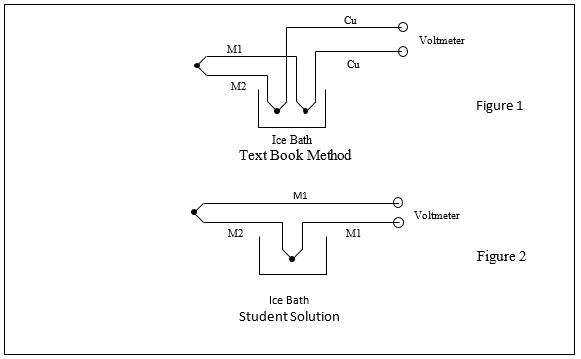As a result of the advanced method of Cold Junction Compensation (CJC) used in Dataforth Corporation's
MAQ20 thermocouple modules,
the accuracy of these modules is significantly better than that offered by competing models.
The Dataforth MAQ20-JTC, -KTC, -TTC and -RSTC thermocouple, input modules have eight differential input channels, which are grouped into four blocks of two channels. Each block has a terminal for sensor shield ground as well as a dedicated ambient temperature sensor that is optimally positioned to accurately measure the terminal block temperature in any system configuration, any module orientation, and over the entire operating temperature range of -40°C to +85°C. Four cold junction compensation (CJC) temperature sensors are located in a space of only two inches. Precise cold junction compensation can only be accomplished with precise measurement of the terminal block temperature where the dissimilar metal, wire pair is terminated.
A thermocouple is simply two wires of dissimilar metals welded together at one end. Nothing happens at that end. Differing thermoelectric potential is developed as both wires travel through a temperature gradient eventually ending at a terminal block. The different wires have differing thermoelectric potential responses to the temperature gradient. Thus a voltage can be measured at the terminal block. At the joined end of the wires, no voltage difference exists. When the temperature at the terminal block is known, thermoelectric data for the two particular dissimilar wires may be used to infer the temperature at the point of the join. After the terminal block, additional wiring continues on to the point of measurement. These wires may also travel through another temperature gradient, but presumably, these instrumentation wires are made of the same material, usually copper; therefore, there is no net additional voltage measured. If this instrumentation wiring is constructed of dissimilar metals, another thermocouple has been created, possibly creating an error.
When multiple sensor input connections are spread out over a distance, temperature gradients over the terminal blocks are naturally present due to convective heating, transient air currents caused by opening and closing instrumentation cabinets, and local heat sources from adjacent electronics. Only when an ambient temperature sensor is integrally mounted with the terminal block, and only when that temperature sensor has the same thermal response time as the terminal block, can precise cold junction compensation take place over static and dynamic ambient temperature conditions. Many competing products only have a single temperature sensor to compensate multiple input channels. Often this sensor cannot effectively measure gradients or respond with the same thermal characteristic as the multiple input terminal blocks.
Dataforth's CJC specification:
±0.25°C typical accuracy at 25°C ambient
±1.0°C typical accuracy over -40°C to +85°C ambient.
Dataforth's initial engineering development, thermocouple prototype, used the standard 20-pin pluggable terminal block used on other MAQ20 input modules, and it used a single, internal, CJC sensor. According to VP Product Development John Lehman, "We measured up to an 8 degree Centigrade gradient from the top to the bottom of the input terminal block in typical system configurations, so the best we could hope for was to put the sensor in the middle and compensate with +4°C to -4°C accuracy for the top and bottom channels. A 1°C CJC accuracy specification was just not possible." Compared to other products, Dataforth’s MAQ20 thermocouple, input modules provide better performance at one-half to one-third the cost and in a much more user friendly package! These modules are able to ensure such greatly improved accuracy because of their leading-edge design, which provides the precise terminal block temperature measurements that are essential for precise cold junction compensation.
A physics problem in thermocouple application:
Suppose a physics professor assigned a lab experiment to measure the temperature of a Bunsen burner. The class is given a burner, a thermocouple (TC), an ice bath, digital voltmeter, and data table for the TC. The class proceeds but soon remarks to the professor that the diagram in their text book shows connections of both ends of the TC to two copper wires and puts both of these joins into the ice bath. The professor replies, “None are available; see what you can do.” After much concern a clever student has a thought. Cut off two pieces from one of the thermocouple wires and use those.
An even more clever student said that would work, but only one piece is needed. Hook it up as shown in Figure 2. He explained it this way. “Consider what we would have if we inserted the middle of the M1 wire connected to the positive terminal of the meter and the TC into the ice bath. Now we have the same situation as the text book method; except we come back to the meter on two M1 wires. When we pull this same wire out of the water, there is no change; because the net thermoelectric potential change from the positive, volt meter terminal to the TC is still the same. It goes down into the colder ice and up to the hotter TC at the Bunsen burner, or alternately straight to the TC.” No change between the two wire routes was measured. In the text book method, it matters not whether we use a pair of copper, iron, or M1 wires to connect the volt meter. Theory and observed data agree. Q.E.D.

Dataforth was established in 1984 and is a world leader in data acquisition and control, signal conditioning, and data communication products for industrial applications.
Worldwide, our products provide rugged signal and data integrity and wide spectrum accuracy.
All Dataforth products are manufactured in the USA and have been RoHS Compliant since 2006.
The Dataforth Quality Management System is ISO9001:2015 registered.
For additional information, call 800-444-7644 toll-free or email sales@dataforth.com.